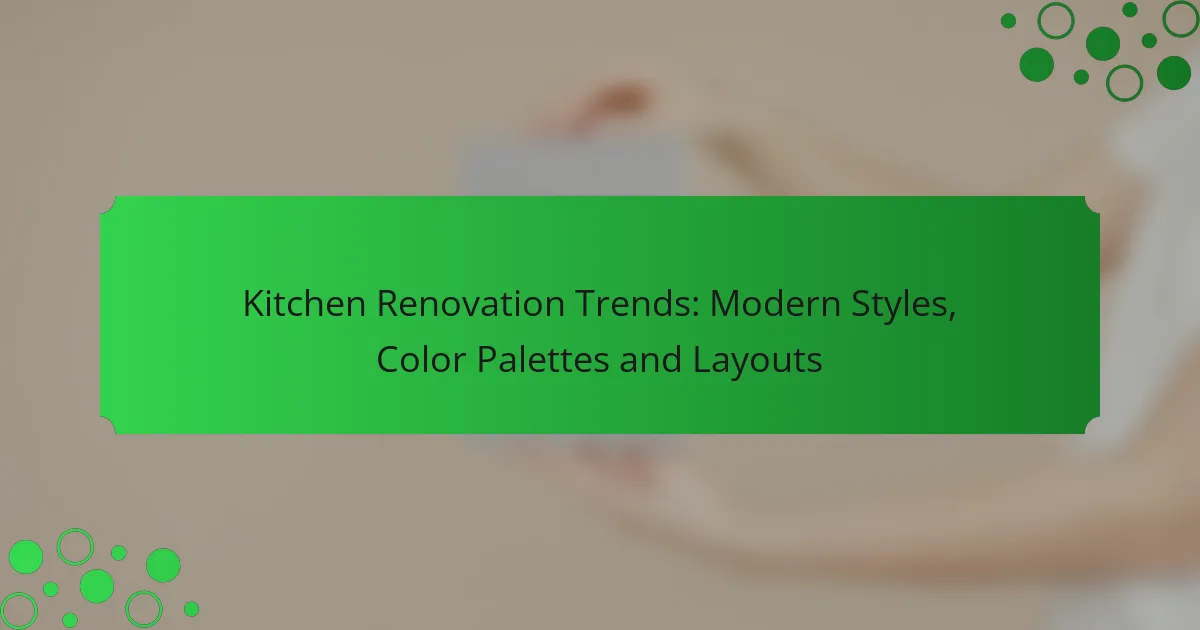Kitchen renovation trends are evolving to prioritize open-concept designs, smart technology, and eco-friendly materials, all while embracing minimalist aesthetics and bold color accents. Homeowners are focusing on creating functional spaces that reflect their personal style, with careful consideration given to color palettes that enhance the overall theme of their homes. Popular layouts such as U-shaped, L-shaped, and galley designs cater to various cooking styles and spatial needs, ensuring that every kitchen is both practical and visually appealing.

What are the latest kitchen renovation trends in the United States?
The latest kitchen renovation trends in the United States emphasize open-concept spaces, smart technology, eco-friendly materials, minimalist aesthetics, and bold color accents. Homeowners are increasingly looking for designs that enhance functionality while reflecting personal style.
Open-concept layouts
Open-concept layouts continue to dominate kitchen renovations, promoting a seamless flow between the kitchen, dining, and living areas. This design not only maximizes space but also encourages social interaction, making it ideal for families and entertaining guests.
When considering an open-concept layout, think about the placement of furniture and appliances to maintain an efficient workflow. Ensure that there is adequate lighting and ventilation to create a comfortable environment.
Smart kitchen technology
Smart kitchen technology is becoming a staple in modern renovations, with features like smart refrigerators, voice-activated assistants, and automated lighting systems. These innovations enhance convenience and efficiency, allowing homeowners to manage their kitchens with ease.
When integrating smart technology, focus on compatibility and ease of use. Look for devices that can connect to a central hub for streamlined control, and consider energy-efficient options to reduce utility costs.
Eco-friendly materials
Eco-friendly materials are increasingly popular in kitchen renovations, reflecting a growing awareness of sustainability. Options such as bamboo cabinetry, recycled countertops, and low-VOC paints contribute to a healthier home environment.
When selecting eco-friendly materials, research certifications like FSC (Forest Stewardship Council) for wood products and look for suppliers that prioritize sustainable practices. This not only benefits the environment but can also enhance the appeal of your kitchen.
Minimalist designs
Minimalist designs focus on simplicity and functionality, often featuring clean lines and uncluttered spaces. This trend emphasizes quality over quantity, encouraging homeowners to invest in fewer, high-quality pieces.
To achieve a minimalist look, choose a neutral color palette and limit decorative items. Consider built-in storage solutions to keep countertops clear and maintain an organized appearance.
Bold color accents
Bold color accents are making a statement in kitchen renovations, adding personality and vibrancy to spaces. Homeowners are opting for striking hues in cabinetry, backsplashes, and accessories to create focal points.
When incorporating bold colors, balance them with neutral tones to avoid overwhelming the space. Use color strategically in smaller areas, such as an island or a feature wall, to enhance visual interest without compromising cohesion.

How can I choose the right color palette for my kitchen renovation?
Choosing the right color palette for your kitchen renovation involves considering your style preferences, the overall theme of your home, and the mood you want to create. Aim for a cohesive look that balances aesthetics and functionality, ensuring the colors complement each other and enhance the space.
Neutral tones for a timeless look
Neutral tones such as whites, grays, and beiges provide a classic backdrop for any kitchen. These colors create a sense of calm and can make the space feel larger and more open. Pairing neutral shades with natural materials like wood or stone can enhance the timeless appeal.
When selecting neutral tones, consider using varying shades to add depth. For instance, a light gray for the walls combined with a darker gray for cabinetry can create a sophisticated contrast without overwhelming the senses.
Contrasting colors for visual interest
Using contrasting colors can add dynamic energy to your kitchen. For example, pairing a bold navy blue with crisp white cabinetry creates a striking visual effect. This approach can highlight specific areas, such as an island or backsplash, making them focal points.
When opting for contrasting colors, be mindful of balance. Too many bold colors can create chaos, so limit the palette to two or three main colors. This keeps the design cohesive while still allowing for visual excitement.
Pastel shades for a soft ambiance
Pastel shades like soft pinks, mint greens, and light blues can create a gentle and inviting atmosphere in your kitchen. These colors work well in both modern and traditional designs, offering a fresh and airy feel. Pastels can also be easily paired with white or light wood finishes for a harmonious look.
To incorporate pastel shades effectively, consider using them in smaller accents, such as kitchen accessories, or as a primary color on cabinetry. This approach allows for flexibility and can be adjusted easily if you want to change the kitchen’s mood in the future.

What modern kitchen layouts are popular?
Popular modern kitchen layouts include U-shaped, L-shaped, and galley designs. Each layout offers unique advantages and considerations, making them suitable for different spaces and cooking styles.
U-shaped kitchens
U-shaped kitchens feature three walls of cabinetry and appliances, creating a functional work triangle. This layout is ideal for larger spaces, allowing multiple cooks to work simultaneously without crowding.
When designing a U-shaped kitchen, consider incorporating an island for additional prep space or seating. Ensure that the distance between the walls is adequate, typically around 10 to 12 feet, to facilitate movement and workflow.
L-shaped kitchens
L-shaped kitchens consist of two adjoining walls, forming an L shape that maximizes corner space. This layout is versatile and works well in both small and large kitchens, offering an open feel while still providing ample storage and counter space.
To enhance an L-shaped kitchen, consider adding a peninsula or island for extra functionality. Keep in mind that the distance between the two walls should ideally be between 7 to 10 feet to maintain an efficient workflow.
Galley kitchens
Galley kitchens feature two parallel walls with a narrow walkway in between, making them highly efficient for cooking. This layout is particularly suitable for smaller homes or apartments where space is limited.
When designing a galley kitchen, prioritize storage solutions such as vertical cabinets and open shelving to maximize space. Ensure that the walkway is at least 4 feet wide to allow for easy movement and access to appliances.

What factors should I consider when planning a kitchen renovation?
When planning a kitchen renovation, consider your budget, space utilization, and style preferences. These factors will guide your decisions and help you create a functional and aesthetically pleasing kitchen.
Budget constraints
Your budget is a critical factor in any kitchen renovation. Determine how much you can afford to spend, including materials, labor, and unexpected expenses. A typical kitchen remodel can range from a few thousand to tens of thousands of dollars, depending on the scope of work.
To manage costs effectively, prioritize your needs versus wants. Focus on essential upgrades like cabinetry and appliances before considering luxury items. Always set aside a contingency fund of around 10-20% of your total budget for unforeseen costs.
Space utilization
Efficient space utilization is vital for a functional kitchen. Assess your current layout and identify areas that can be optimized, such as adding storage solutions or reconfiguring work zones. The kitchen work triangle—consisting of the stove, sink, and refrigerator—should be efficient and unobstructed.
Consider incorporating multi-functional furniture or built-in appliances to maximize space. Open shelving can also create an illusion of more room while providing easy access to frequently used items. Ensure that your design allows for smooth traffic flow, especially in smaller kitchens.
Style preferences
Your style preferences will significantly influence the overall look of your kitchen. Decide on a design theme that resonates with you, whether it’s modern, traditional, or farmhouse. This will guide your choices in colors, materials, and finishes.
When selecting colors, consider current trends such as neutral palettes combined with bold accents. For example, pairing white cabinetry with navy blue islands can create a striking contrast. Additionally, choose durable materials that align with your style, such as quartz countertops for a contemporary feel or reclaimed wood for a rustic touch.

What are the benefits of hiring a professional kitchen designer?
Hiring a professional kitchen designer offers numerous advantages, including tailored design solutions and efficient space utilization. Their expertise can help you avoid costly mistakes and ensure that your kitchen meets both aesthetic and functional needs.
Expertise in space planning
Professional kitchen designers excel in space planning, which is crucial for creating an efficient and functional kitchen layout. They understand how to maximize the available space, ensuring that every square foot serves a purpose while maintaining a comfortable flow.
When planning your kitchen, designers consider factors such as the work triangle, which involves the optimal distance between the sink, stove, and refrigerator. This principle helps streamline cooking and food preparation, making your kitchen more user-friendly.
Additionally, a designer can help you choose the right cabinetry and appliances that fit your space without overcrowding it. They often have access to custom solutions that can enhance both storage and accessibility, ensuring your kitchen is both practical and stylish.
